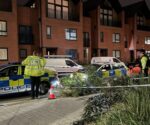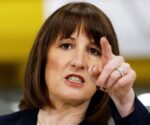When the V-bombers were the nation’s only defence against armageddon | History | News
Vulcan crew scrambles during Cold War exercise in February 1965 (Image: Mirrorpix via Getty)
The new delta-wing Avro Vulcan was a revelation. Movietone newsreel footage of the 1955 Farnborough Airshow reveals test pilot Roland “Roly” Falk blasting into the damp September sky at the controls of XA890, the second production aircraft, and, wonder-of-wonders, barrel-rolling the 69-ton machine as it climbs above a crowd of senior politicians – including the prime minister Anthony Eden, military top brass and a thrilled, raincoated public.
Impeccably dressed as always in bespoke suit, tie, cufflinks, pocket handkerchief and sunglasses, Falk made flying a nuclear bomber no more difficult than, and as stylish as, rolling up at Claridge’s for a cocktail. There is a delightful photograph, taken on August 30, 1952, of Falk posed on the cockpit ladder of the prototype Avro 698 – the Vulcan name came later – at Avro’s Woodford Aerodrome, south of Manchester.
John Falk, Roly’s son, relived this moment 70 years later when he posed on the cockpit ladder of Vulcan XL426, preserved at Southend Airport. He wore a suit and tie, but also a lanyard and a high-vis jacket, a sign of our times that his father would have snorted at. Safety matters, of course, yet the Vulcan was a one of a trio of new V-Force British bomber types – the others were the Vickers Valiant and the Handley Page Victor.
They were all designed to fly high, gunless and fast, as close to Soviet targets as possible where they would unleash H-bombs a thousand times more powerful than those dropped by USAAF Boeing B-29 Superfortresses on Hiroshima and Nagasaki 80 years ago this month. How safe was that?
The mainstay of Britain’s nuclear deterrence from the mid-1950s to 1969 – when Royal Navy Polaris submarines superseded them – the RAF’s V-bombers were, thankfully, never to launch nuclear weapons in anger, although they did appear to come very close to doing so at the time of the Cuban Missile Crisis.

The Handley Page B2 Victor bomber looks gloriously menacing on the runway in 1959 (Image: Getty)
Before he left his married quarters at RAF Coningsby on Friday, October 26, 1962, newly commissioned Pilot Officer Peter West, a young air electronics officer, told his wife: “I want you to take the children, put them in the car, put a few things in the car with them, and get the hell out of there. Drive to Scotland. Go to your brother in Skye. You’ll probably be safe there.”
Speaking to the BBC 45 years after the event, West recalled: “If we had gone, the chances are we would have been dead anyway and even if we had got back safely, there would be nothing to come back to. Long afterwards, my wife said that she thought to herself at the time: ‘What a bloody fool. Where does he think I’m going to? How far does he think I’ll get? I would be passing all the airfields, all of which would be primary targets!’”
Mrs West was right. Even if, somehow, and in a very fast car, she had made it to Skye, RAF Machrihanish on the west coast of Scotland, one of the RAF’s nuclear bomber dispersal bases, may well have been hit by the time she got there. Mrs West felt it would have been best to stay at home with the children. If the family were to die, it would be with the children in their mother’s arms as the Russian nuclear missiles struck home.
While fully prepared to fly their Armageddon missions on that knife-edge October weekend, West and his fellow crew members trusted the sanity of MAD, the Cold War doctrine of Mutual Assured Destruction by which an attack by one side on another with nuclear weapons would lead to an instant response – causing the annihilation of both parties.
Although last minute diplomacy saved the day and the V-bombers were stood down, it had been a close-run thing. Remarkably, according to the Bulletin of Atomic Scientists, “the world population, to a large degree, was unaware of what exactly had just happened. Or, more precisely, what hadn’t happened”.

The Vickers Valiant was the UK’s first nuclear-capable bomber (Image: Mirrorpix)
Read more: ‘Most harrowing war film ever’ shows what happens if a nuke hits UK
Read more: British fighter jets to carry nuclear bombs for the first time in DECADES
In Britain that Saturday, when Captain Valentin Savitsky very nearly fired a nuclear-tipped torpedo from his Foxtrot-class submarine at one of the US ships preventing the delivery of Soviet nuclear missiles to Cuba, many people were simply out shopping or watching football. Arsenal beat Wolves 5-4. Hearts beat Kilmarnock 1-0. The deadly match between NATO and the Soviet Union ended in a nail-biting draw.
The Air Ministry specification – B.35/46 – that led, officially, to the V-bombers had been issued on January 7, 1947. That was the day Clement Attlee’s Labour government committed Britain to the development of an atomic bomb independent of the US, which was going through one of its isolationist phases. As long- range missile technology was not yet up to speed, Britain looked to a new generation of high-altitude jet bombers to carry the bombs.
Three designs were selected (a fourth, the Short Sperrin, was cancelled); this was not too many as, given this was new technology, it was deemed wise to invest in competing designs in case one or even two were flawed.
It must be remembered that these swept, delta and crescent-wing jets were just years apart from the unpressurised, machine-gun bristling, low-flying, piston-engine heavy bombers – Stirling, Halifax and Lancaster – that took Britain’s war to Germany during the Second World War.
First up was the Vickers Valiant, flying in 1951 and in squadron service four years later, followed by the Vulcan and then the Victor.
The Victor and Vulcan proved to be the more advanced and longer-lived jets, yet it was the Valiant – its service life cut short by metal fatigue in late 1964 – that carried out the complete range of missions expected of V-Force, except for the dropping of nuclear bombs on enemy targets.
The Valiant executed conventional bombing raids during the 1956 Suez Crisis, dropped Britain’s first test A and H-bombs, stood by as a key part of Britain’s nuclear deterrent,and flew reconnaissance and air-to-air refuelling missions.
As a Bomber Command navigator in his early 20s with 49 Squadron, Flight Lieutenant Kenneth Edmonds flew in supporting Valiants during both Operation Buffalo and Operation Grapple; he witnessed, close-up, the dropping of the A-bomb over Maralinga, 500 miles north-west of Melbourne, on October 11, 1956, and the Grapple X H-bomb over the southern tip of Christmas Island on November 8, 1957.

Vulcan test pilot Roly Falk, centre, in his customary pin stripe, after taking VIPs on a test flight (Image: Alamy)

A glorious delta-wing Vulcan bomber, captured in its anti-white flash paint scheme, in 1957 (Image: Popperfoto via Getty)
In July last year, I met Ken Edmonds at his home in Norfolk, east of RAF Marham, the last Victor base. Marham’s F-35 multi-role fighters thundered somewhere in the distance, across the big, burning-blue East Anglian sky. Ken told me: “I was very young then, as were most of us, so it was all a big adventure and for much of the time great fun. I had no real idea of what I’d volunteered for until we arrived at Maralinga.
“Once there, we quickly understood the enormity of the operation – politically, scientifically and militarily – but the camaraderie was such that it was a real pleasure to be involved. The set-up was happily informal.
“We all mucked in together – air crews, ground crews including recruits on National Service and scientists from Aldermaston led by Sir William Penney, a delightful man. There were no heroics involved on our part in either operation. We were doing a job.”
What Ken witnessed, among other experiments, were H-bomb mushroom clouds, “strangely beautiful, rising to 60,000ft and even higher in shimmering orange, yellow and gold… a terrible beauty”.
The rapid development of deadly Soviet ground-to-air missiles brought V-Force down to earth. From 1962, these charismatic, pure white aircraft were repainted in camouflage colours and flown at low levels.
This was the straw that broke the Valiant’s back and led the Victors to be re-assigned to air-to-air fuel tanker and reconnaissance duties. The Vulcan flew on as a bomber, gaining legendary fame with its conventional bomb raids on Port Stanley airfield during the Falklands War.
A solitary, privately operated Vulcan, XH558 The Spirit of Great Britain, restored by the Vulcan to the Sky Trust, kept the V-Force flame burning until 2015, putting on airshows witnessed by two million people – the kind Roly Falk would have revelled in. Earlier this year, the Government announced that Britain would buy US F-35-A stealth fighters capable of carrying tactical nuclear weapons.
Today, V-Force may be history, and Woodford Aerodrome, the home of the Vulcan, closed in 2011 to be replaced by an anonymous housing estate – yet the terrifying technology that gave it wings has yet to be defused.
- V-Force: Britain’s Nuclear Bombers and the Cold War, by Jonathan Glancey (Atlantic Books, £22) is out now

V-Force by Jonathan Glancey looks at the Cold War legacy of Britain’s aircraft industry (Image: Atlantic Books)








